Preliminary Study on an Integrated System Composed of a Floating Offshore Wind Turbine and an Octagonal Fishing Cage
Abstract
1. Introduction
2. Structural Model
2.1. Frame Structure of Fishing Cage
2.2. Net System
2.3. Mooring Line System
2.4. Wind Turbine System
3. Dynamics Modeling
3.1. Aerodynamics and Structural Dynamics
3.2. Mooring Line Dynamics
3.3. Hydrodynamics of Aquaculture Cage
3.3.1. Hydrodynamics of Cage Support Structures
3.3.2. Net Hydrodynamics
4. Control System
5. Results and Discussions
5.1. Free Decay Test
5.2. Uniform Wind with Regular and Irregular Waves Test
5.3. Turbulent Wind and Irregular Wave Test
5.3.1. Time Domain Analysis
5.3.2. Frequency Domain Analysis
5.4. Influence of Mooring Line Length
6. Conclusions
Author Contributions
Funding
Data Availability Statement
Conflicts of Interest
References
- Jin, J.; Su, B.; Dou, R.; Luan, C.; Li, L.; Nygaard, I.; Fonseca, N.; Gao, Z. Numerical modelling of hydrodynamic responses of Ocean Farm 1 in waves and current and validation against model test measurements. Mar. Struct. 2021, 78, 103017. [Google Scholar] [CrossRef]
- Chu, Y.I.; Wang, C.M. Hydrodynamic Response Analysis of Combined Spar Wind Turbine and Fish Cage for Offshore Fish Farms. Int. J. Struct. Stab. Dyn. 2020, 20, 2050104. [Google Scholar] [CrossRef]
- Holm, P.; Buck, B.H.; Langan, R. Introduction: New Approaches to Sustainable Offshore Food Production and the Development of Offshore Platforms. In Aquaculture Perspective of Multi-Use Sites in the Open Ocean; Springer: Cham, Switzerland, 2017; pp. 1–20. [Google Scholar] [CrossRef]
- Chu, Y.I.; Wang, C.M. Combined Spar and Partially Porous Wall Fish Cage for Offshore Site. In EASEC16; Springer: Singapore, 2020; pp. 569–581. [Google Scholar] [CrossRef]
- Dou, R. Numerical Modeling and Analysis of a Semi-Submersible Fish-Cage. Master’s Thesis, NTNU, Trondheim, Norway, 2018. [Google Scholar]
- Huang, J.; Chang, C.O.; Chang, C.C. Analysis of Structural Vibrations of Vertical Axis Wind Turbine Blades via Hamilton’s Principle—Part 1: General Formulation. Int. J. Struct. Stab. Dyn. 2020, 20, 2050098. [Google Scholar] [CrossRef]
- Alam, M.; Chao, L.-M.; Rehman, S.; Ji, C.; Wang, H. Energy harvesting from passive oscillation of inverted foil. Phys. Fluids 2021, 33, 075111. [Google Scholar] [CrossRef]
- Jahangiri, V.; Ettefagh, M.M. Multibody Dynamics of a Floating Wind Turbine Considering the Flexibility Between Nacelle and Tower. Int. J. Struct. Stab. Dyn. 2018, 18, 1850085. [Google Scholar] [CrossRef]
- Rehman, S. Wind Power Resources Assessment at Ten Different Locations using Wind Measurements at Five Heights. Environ. Prog. Sustain. Energy 2022, 41, e13853. [Google Scholar] [CrossRef]
- Otter, A.; Murphy, J.; Pakrashi, V.; Robertson, A.; Desmond, C. A review of modelling techniques for floating offshore wind turbines. Wind Energy 2021, 25, 831–857. [Google Scholar] [CrossRef]
- Russo, S.; Contestabile, P.; Bardazzi, A.; Leone, E.; Iglesias, G.; Tomasicchio, G.R.; Vicinanza, D. Dynamic loads and response of a spar buoy wind turbine with pitch-controlled rotating blades: An experimental study. Energies 2021, 14, 3598. [Google Scholar] [CrossRef]
- Bhattacharya, S.; Lombardi, D.; Amani, S.; Aleem, M.; Prakhya, G.; Adhikari, S.; Aliyu, A.; Alexander, N.; Wang, Y.; Cui, L.; et al. Physical Modelling of Offshore Wind Turbine Foundations for TRL (Technology Readiness Level) Studies. J. Mar. Sci. Eng. 2021, 9, 589. [Google Scholar] [CrossRef]
- Zheng, X.Y.; Lei, Y. Stochastic Response Analysis for a Floating Offshore Wind Turbine Integrated with a Steel Fish Farming Cage. Appl. Sci. 2018, 8, 1229. [Google Scholar] [CrossRef]
- Lei, Y.; Zhao, S.X.; Zheng, X.Y.; Li, W. Effects of Fish Nets on the Nonlinear Dynamic Performance of a Floating Offshore Wind Turbine Integrated with a Steel Fish Farming Cage. Int. J. Struct. Stab. Dyn. 2020, 20, 2050042. [Google Scholar] [CrossRef]
- Robertson, A.; Jonkman, J.; Masciola, M.; Song, H.; Goupee, A.; Coulling, A.; Luan, C. Definition of the Semisubmersible Floating System for Phase II of OC4; NREL Technical Report; NREL/TP-5000-60601; National Renewable Energy Lab. (NREL): Golden, CO, USA, 2014. [Google Scholar]
- NS 9415, 2009; Marine Fish Farms Requirement for Site Survey, Risk Analyses, Design, Dimensioning, Production, Installation and Operation. NS 9415, Stardards Norway: Norway.
- Tsukrov, I.; Drach, A.; DeCew, J.; Swift, M.R.; Celikkol, B. Characterization of geometry and normal drag coefficients of copper nets. Ocean Eng. 2011, 38, 1979–1988. [Google Scholar] [CrossRef]
- Li, L.; Ong, M.C. A Preliminary Study of a Rigid Semi-Submersible Fish Farm for Open Seas. In Proceedings of the International Conference on Offshore Mechanics and Arctic Engineering. American Society of Mechanical Engineers, Trondheim, Norway, 25–30 June 2017. [Google Scholar] [CrossRef]
- Wang, Q. Design of a Steel Pontoon-Type Semi-Submersible Floater Supporting the DTU 10MW Reference Turbine. Master’s Thesis, European Wind Energy Master—EWEM, Trondheim, Norway, 2014. [Google Scholar]
- Coulling, A.J.; Goupee, A.J.; Robertson, A.N.; Jonkman, J.M. Importance of Second-Order Difference-Frequency Wave-Diffraction Forces in the Validation of a FAST Semi-Submersible Floating Wind Turbine Model. In Proceedings of the ASME 2013 32nd International Conference on Ocean, Offshore and Arctic Engineering, pages V008T09A019-V008T09A019, Nantes, France, 9 June 2013; American Society of Mechanical Engineers: New York, NY, USA, 2013. [Google Scholar]
- DNV-OS-E301; Position Mooring. Det Norsk Veritas: Oslo, Norway, 2013.
- Jonkman, J.M. Dynamics Modeling and Loads Analysis of an Offshore Floating Wind Turbine. Technical Reports (No. NREL/TP-500-41958); National Renewable Energy Laboratory (NREL): Golden, CO, USA. [CrossRef]
- Jonkman, J.; Butterfield, S.; Musial, W.; Scott, G. Definition of a 5-MW Reference Wind Turbine for Offshore System Development (No. NREL/TP-500-38060); National Renewable Energy Lab.(NREL): Golden, CO, USA, 2009. [Google Scholar]
- Kooijman, H.J.T.; Lindenburg, C.; Winkelaar, D.; van der Hooft, E.L. DOWEC 6 MW Pre-Design: Aero-Elastic Modeling of the DOWEC 6 MW pre-Design in PHATAS, DOWEC Dutch Offshore Wind Energy Converter 1997–2003 Public Reports, DOWEC 10046_009, ECN-CX--01-135, Petten; Energy Research Center of the Netherlands: Petten, The Netherlands, 2003. [Google Scholar]
- Jonkman, J.M.; Buhl, M.L., Jr. Fast User’s Guide-Updated August 2005 (No. NREL/TP-500-38230); National Renewable Energy Lab.(NREL): Golden, CO, USA, 2005. [Google Scholar]
- Ansys, AQWA Reference Manual Release 2019 R1, USA; Ansys Inc.: Canonsburg, PA, USA,, 2019.
- Yang, Y.; Bashir, M.; Michailides, C.; Li, C.; Wang, J. Development and application of an aero-hydro-servo-elastic coupling framework for analysis of floating offshore wind turbines. Renew. Energy 2020, 161, 606–625. [Google Scholar] [CrossRef]
- Moriarty, P.J.; Hansen, A.C. AeroDyn Theory Manual (No. NREL/TP-500-36881); National Renewable Energy Lab.: Golden, CO, USA, 2005. [Google Scholar]
- Jonkman, J.M.; Hayman, G.J.; Jonkman, B.J.; Damiani, R.R.; Murray, R.E. AeroDyn V15 User’s Guide and Theory Manual; NREL: Golden, CO, USA, 2015. [Google Scholar]
- Jonkman, J.M. Modeling of the UAE Wind Turbine for Refinement Of FAST_AD (No. NREL/TP-500-34755); National Renewable Energy Lab.: Golden, CO, USA, 2003. [Google Scholar] [CrossRef]
- Jonkman, J.; Buhl, M. New Developments for the NWTC’s FAST Aeroelastic HAWT Simulator. In Proceedings of the 42nd AIAA Aerospace Sciences Meeting and Exhibit, Reno, NV, USA, 5–8 January 2004. [Google Scholar] [CrossRef][Green Version]
- Newman, J.N. Marine Hydrodynamics; MIT Press: Cambridge, MA, USA, 2018. [Google Scholar]
- Lader, P.F.; Fredheim, A. Dynamic properties of a flexible net sheet in waves and current—A numerical approach. Aquac. Eng. 2006, 35, 228–238. [Google Scholar] [CrossRef]
- Lee, C.W.; Lee, J.; Park, S. Dynamic behavior and deformation analysis of the fish cage system using mass-spring model. China Ocean Eng. 2015, 29, 311–324. [Google Scholar] [CrossRef]
- Moe, H.; Fredheim, A.; Hopperstad, O. Structural analysis of aquaculture net cages in current. J. Fluids Struct. 2010, 26, 503–516. [Google Scholar] [CrossRef]
- Lader, P.; Enerhaug, B. Experimental Investigation of Forces and Geometry of a Net Cage in Uniform Flow. IEEE J. Ocean. Eng. 2005, 30, 79–84. [Google Scholar] [CrossRef]
- Cifuentes, C.; Kim, M. Hydrodynamic response of a cage system under waves and currents using a Morison-force model. Ocean Eng. 2017, 141, 283–294. [Google Scholar] [CrossRef]
- Cifuentes, C.; Kim, M.H. Numerical simulation of fish nets in currents using a Morison force model. Ocean Syst. Eng. 2017, 7, 143–155. [Google Scholar]
- Cha, B.J.; Kim, H.Y.; Bae, J.H.; Yang, Y.S.; Kim, D.H. Analysis of the hydrodynamic characteristics of chain-link woven copper alloy nets for fish cages. Aquac. Eng. 2013, 56, 79–85. [Google Scholar] [CrossRef]
- Løland, G. Current forces on, and water flow through and around, floating fish farms. Aquac. Int. 1993, 1, 72–89. [Google Scholar] [CrossRef]
- Jonkman, J.M. Dynamics of offshore floating wind turbines-model development and verification. Wind Energy 2009, 12, 459–492. [Google Scholar] [CrossRef]
- Hansen, M.H.; Hansen, A.; Larsen, T.J.; Øye, S.; Sørensen, P.; Fuglsang, P. Control Design for a Pitch-Regulated, Variable Speed Wind Turbine; Riso National Laboratory: Roskilde, Denmark, 2005; ISSN 0106-2840. ISBN 87-550-3409-8. [Google Scholar]
- Larsen, T.; Hanson, T.D. A method to avoid negative damped low frequent tower vibrations for a floating, pitch controlled wind turbine. J. Phys. Conf. Ser. 2007, 75, 012073. [Google Scholar] [CrossRef]
- Li, L.; Gao, Z.; Moan, T. Joint Environmental Data at Five European Offshore Sites for Design of Combined Wind and Wave Energy Devices. In Proceedings of the ASME 2013 32nd International Conference on Ocean, Offshore and Arctic Engineering, American Society of Mechanical Engineers Digital Collection, Nantes, France, 9–14 June 2013. [Google Scholar] [CrossRef]
- Xue, W. Design, Numerical Modelling and Analysis of a Spar Floater Supporting the DTU 10MW Wind Turbine. Master’s Thesis, NTNU, Trondheim, Norway, 2016. [Google Scholar]
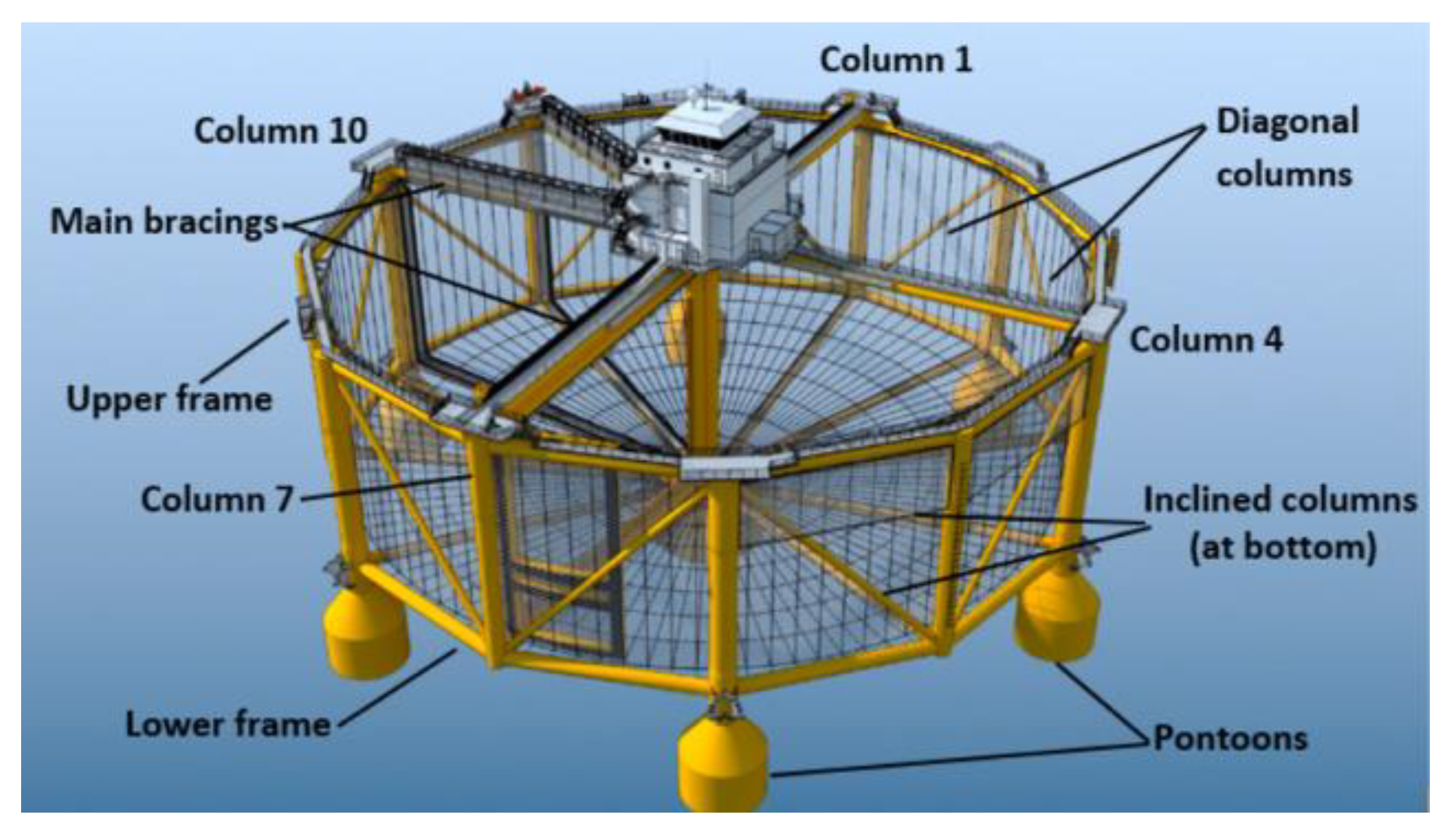


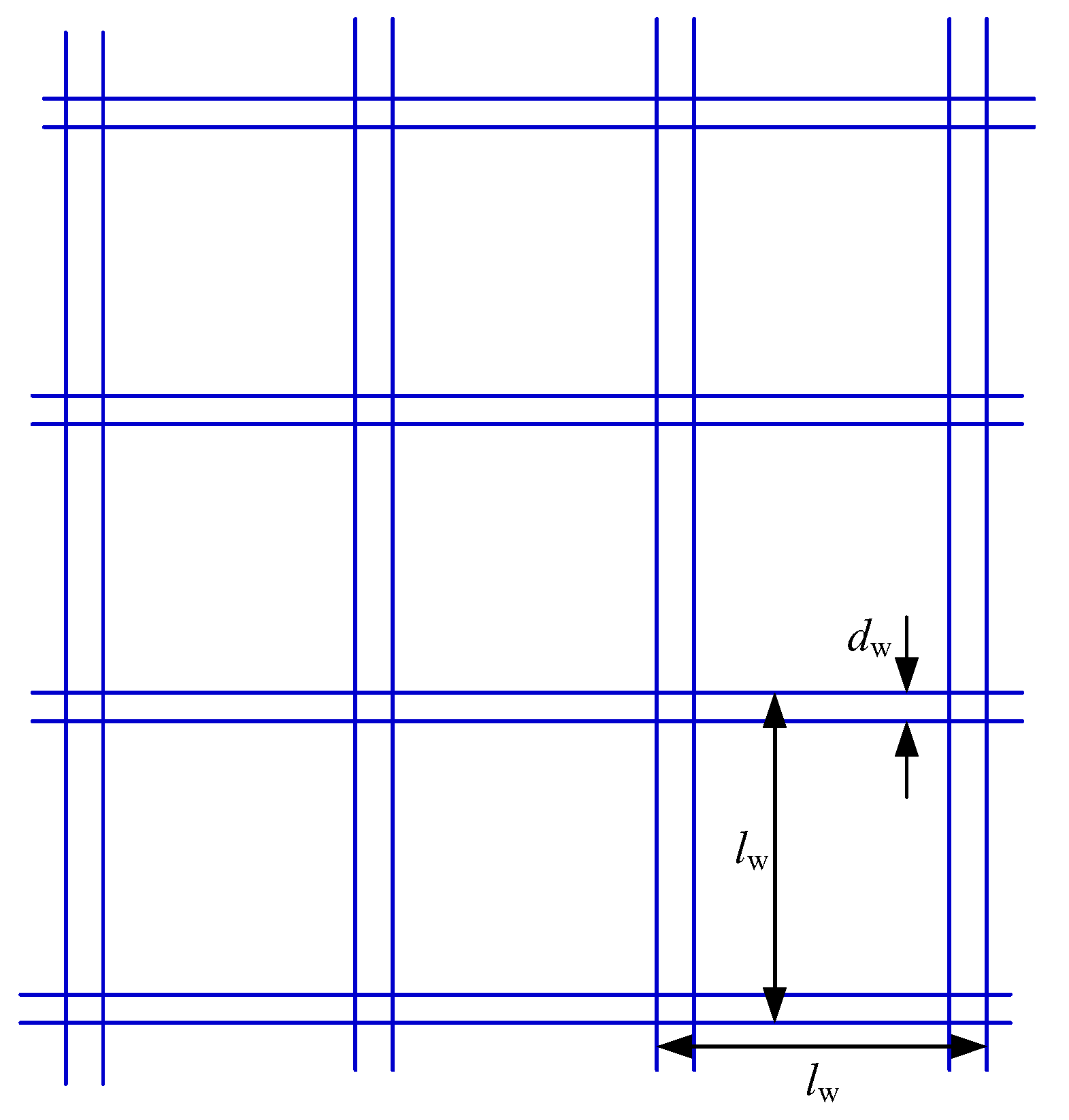
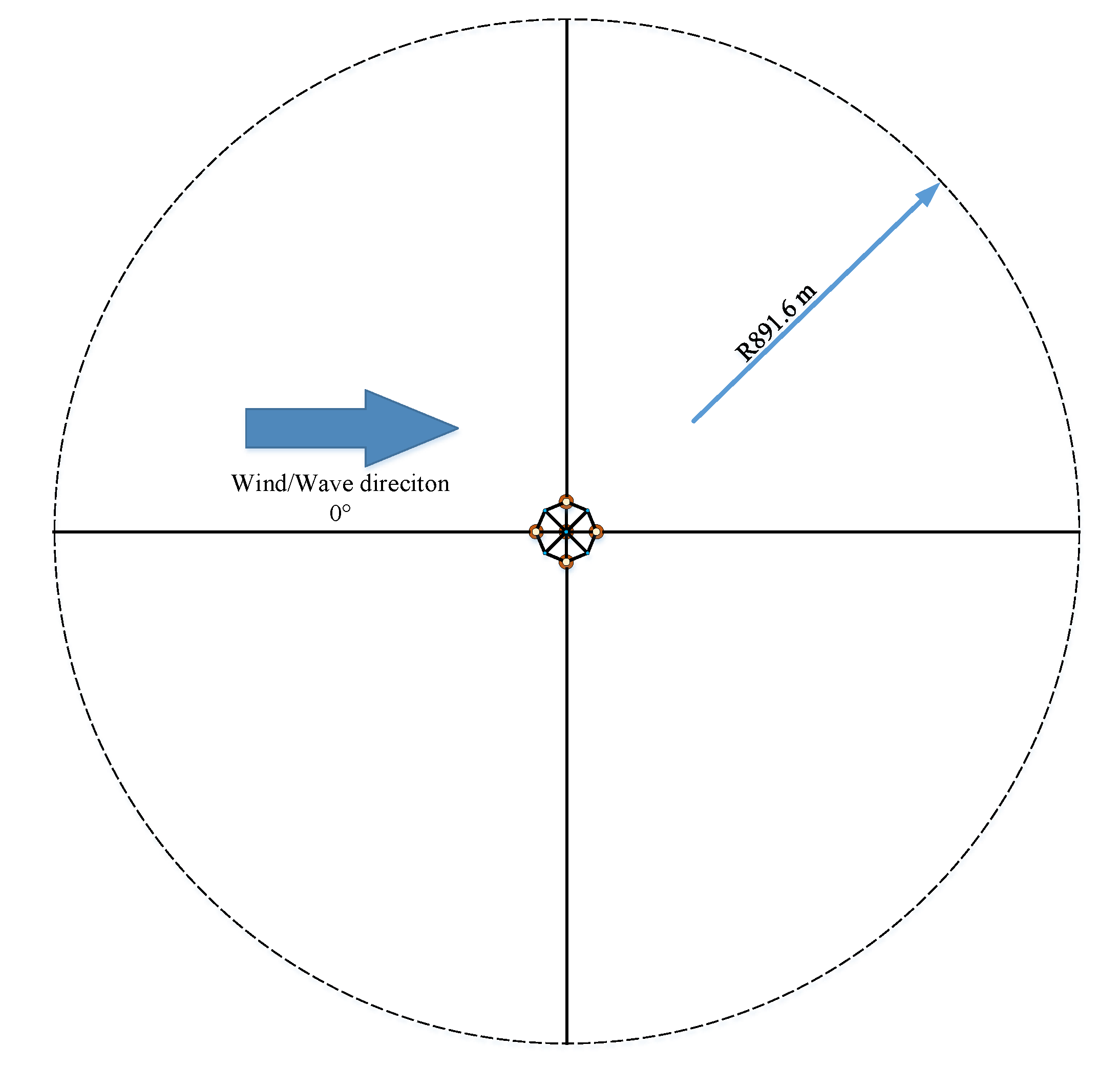
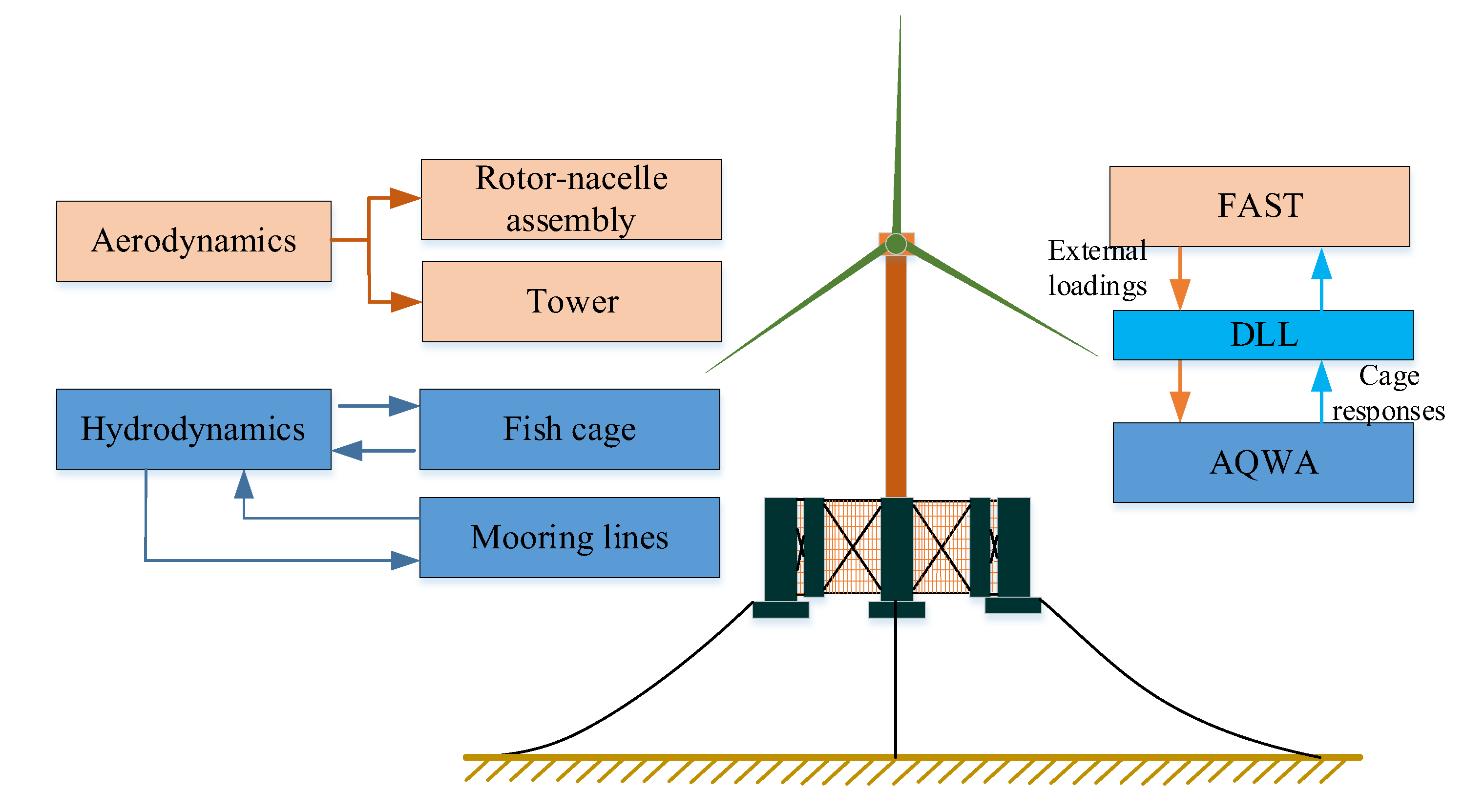
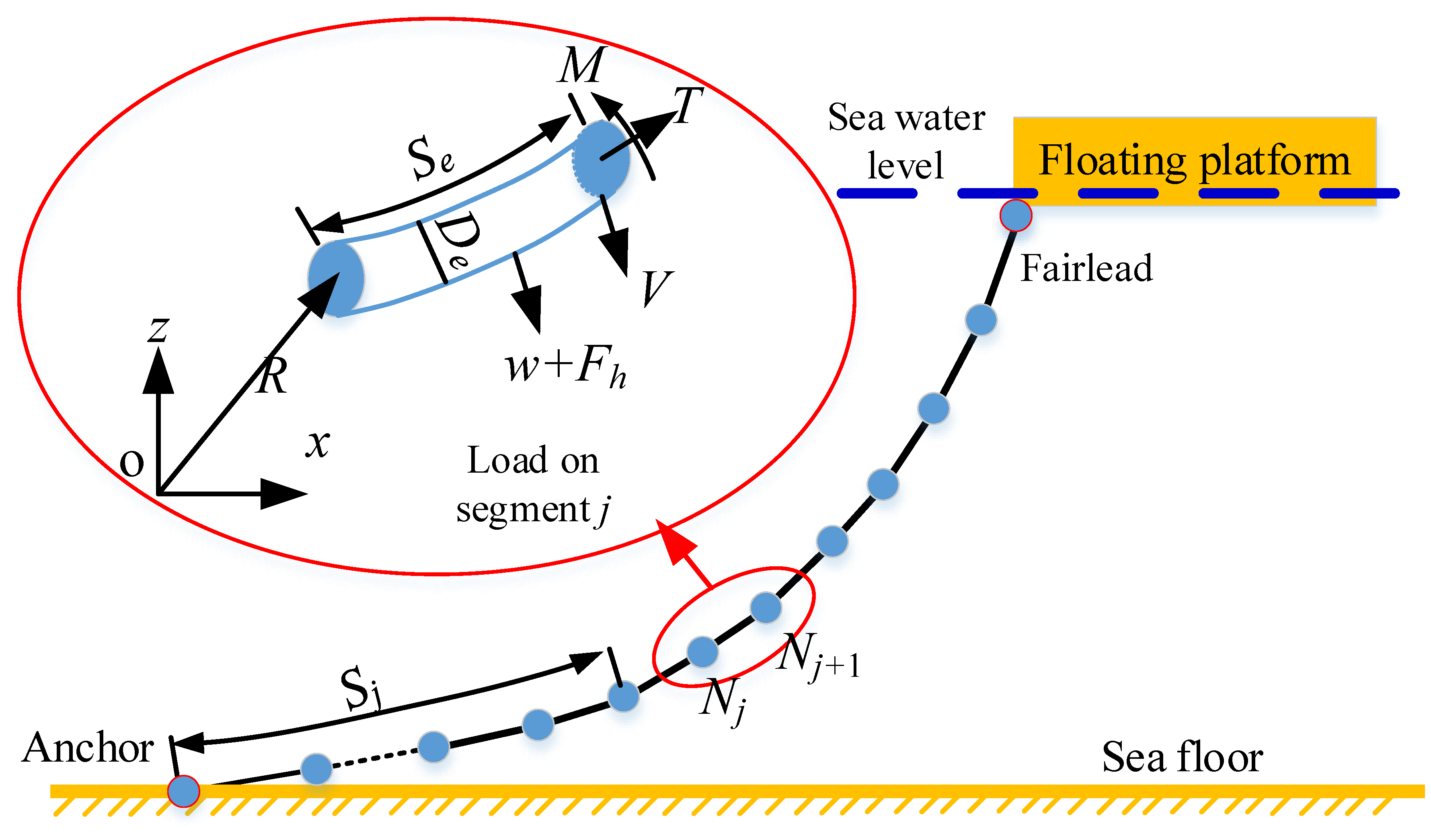
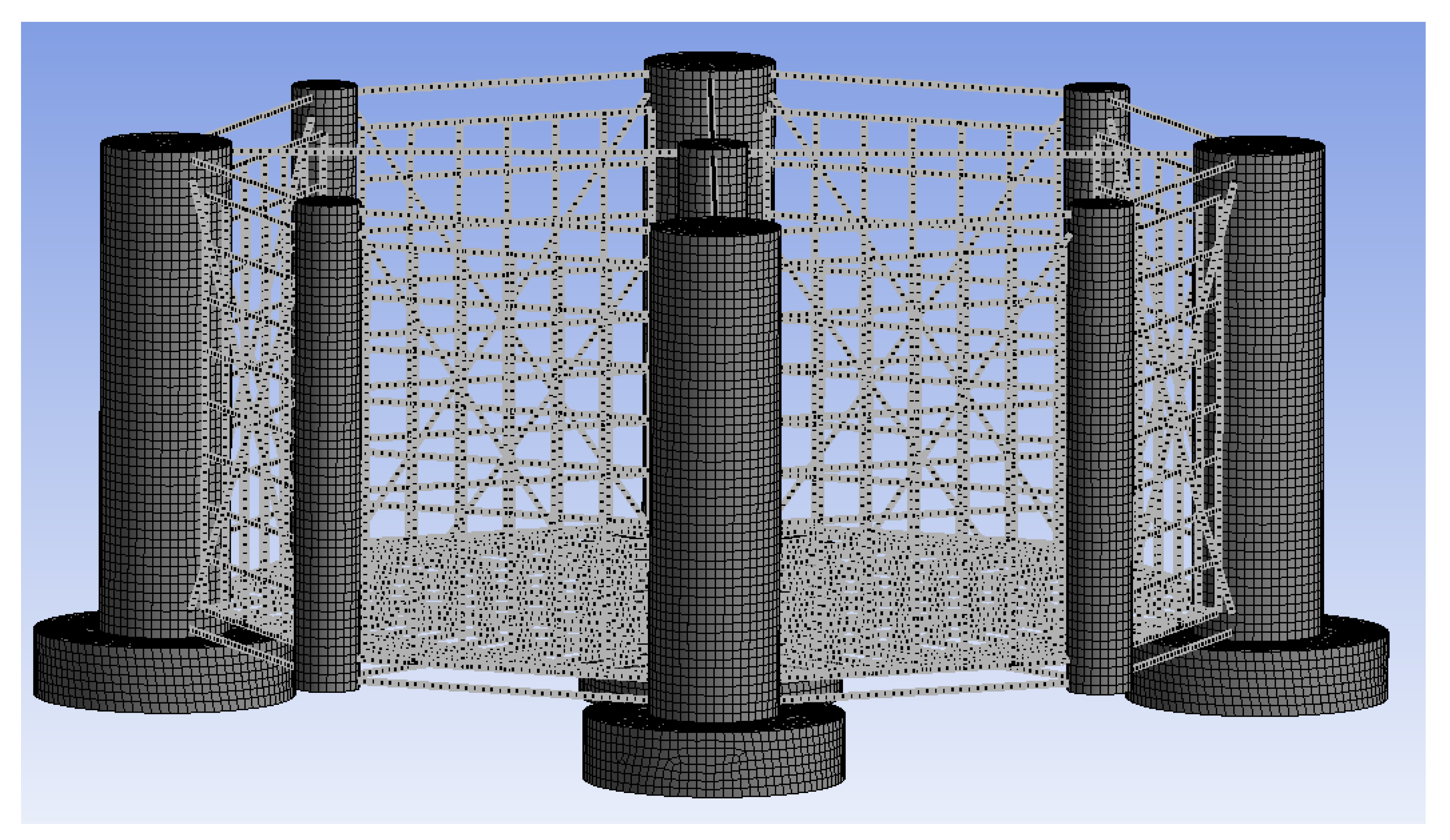
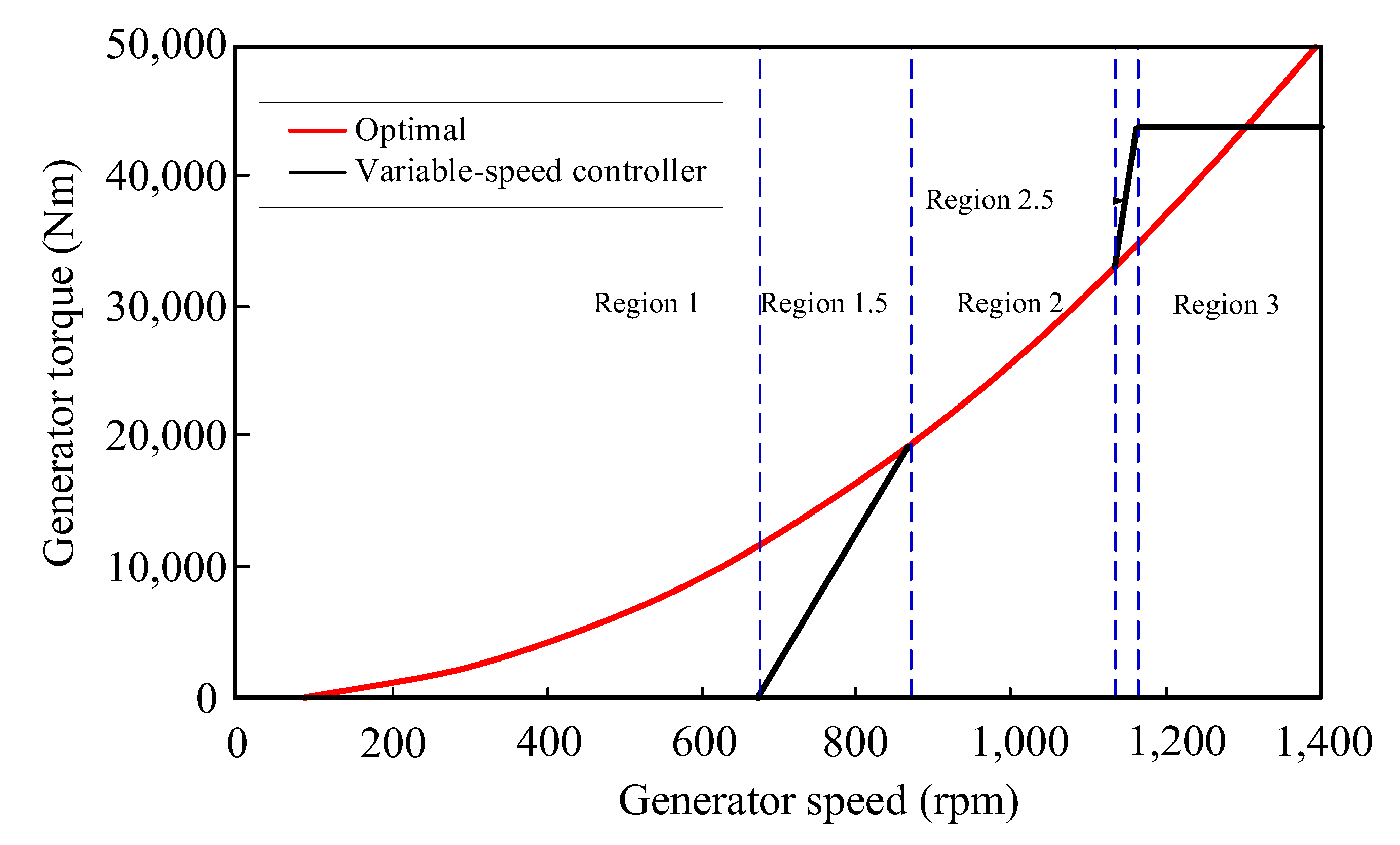
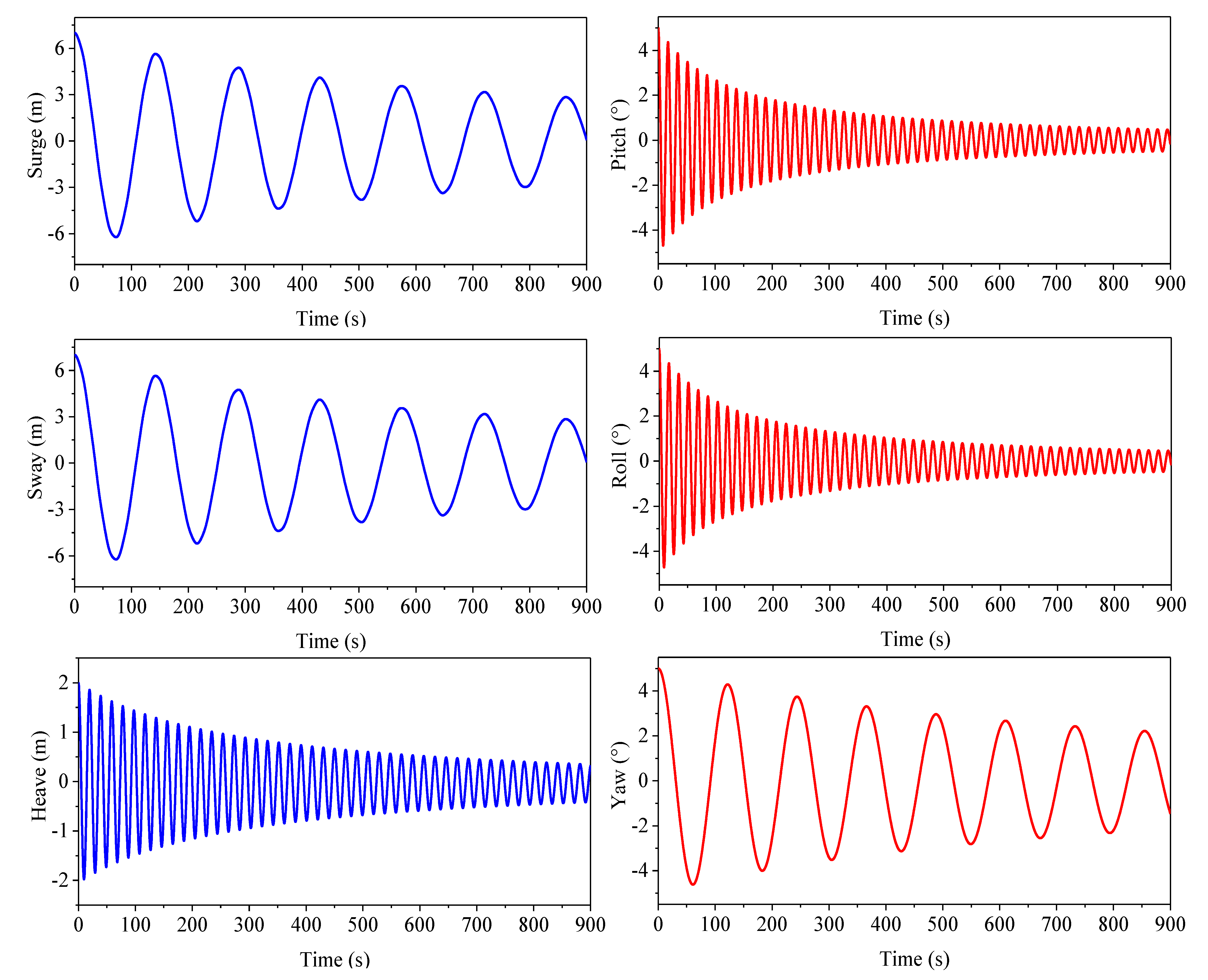
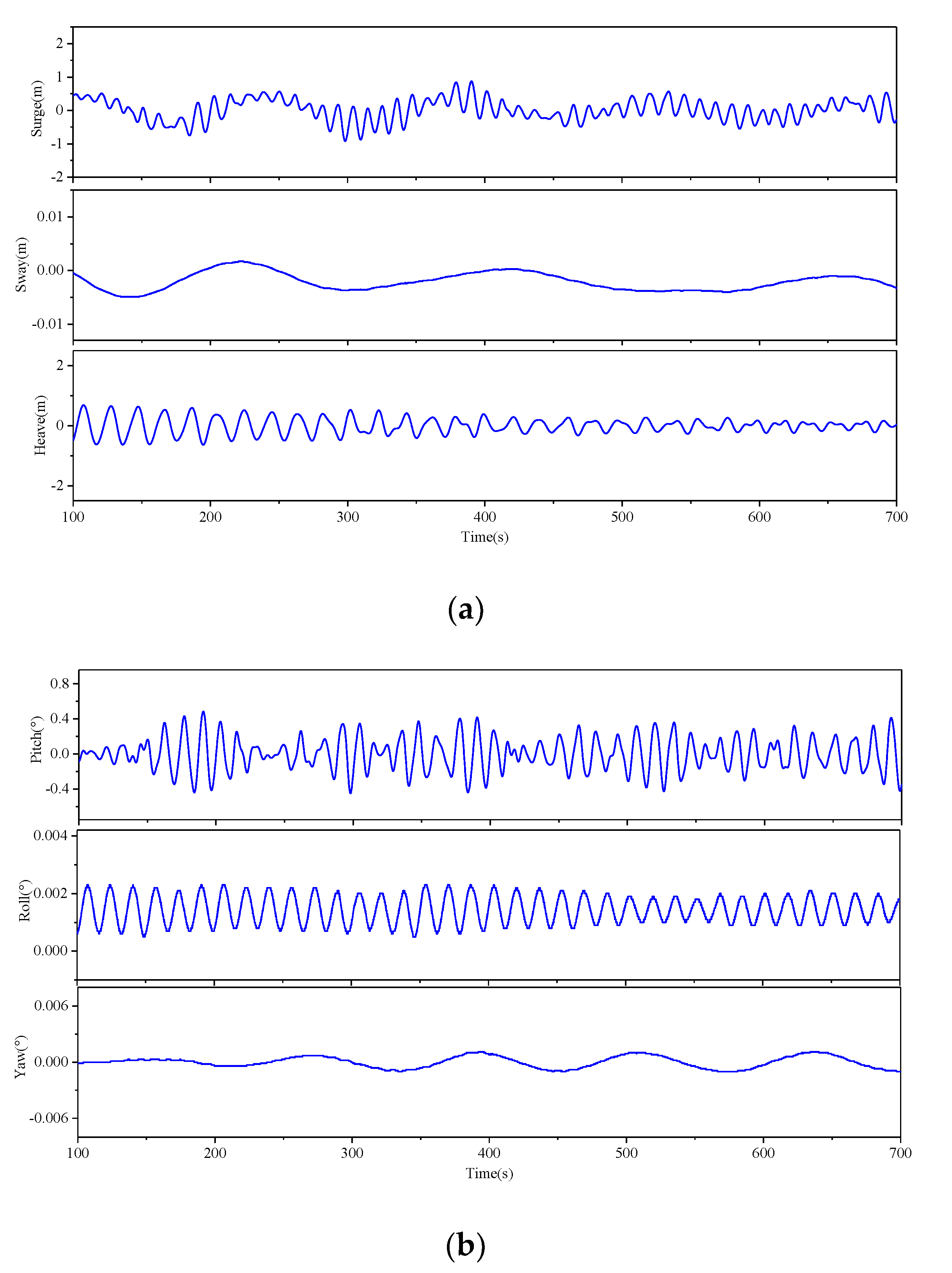
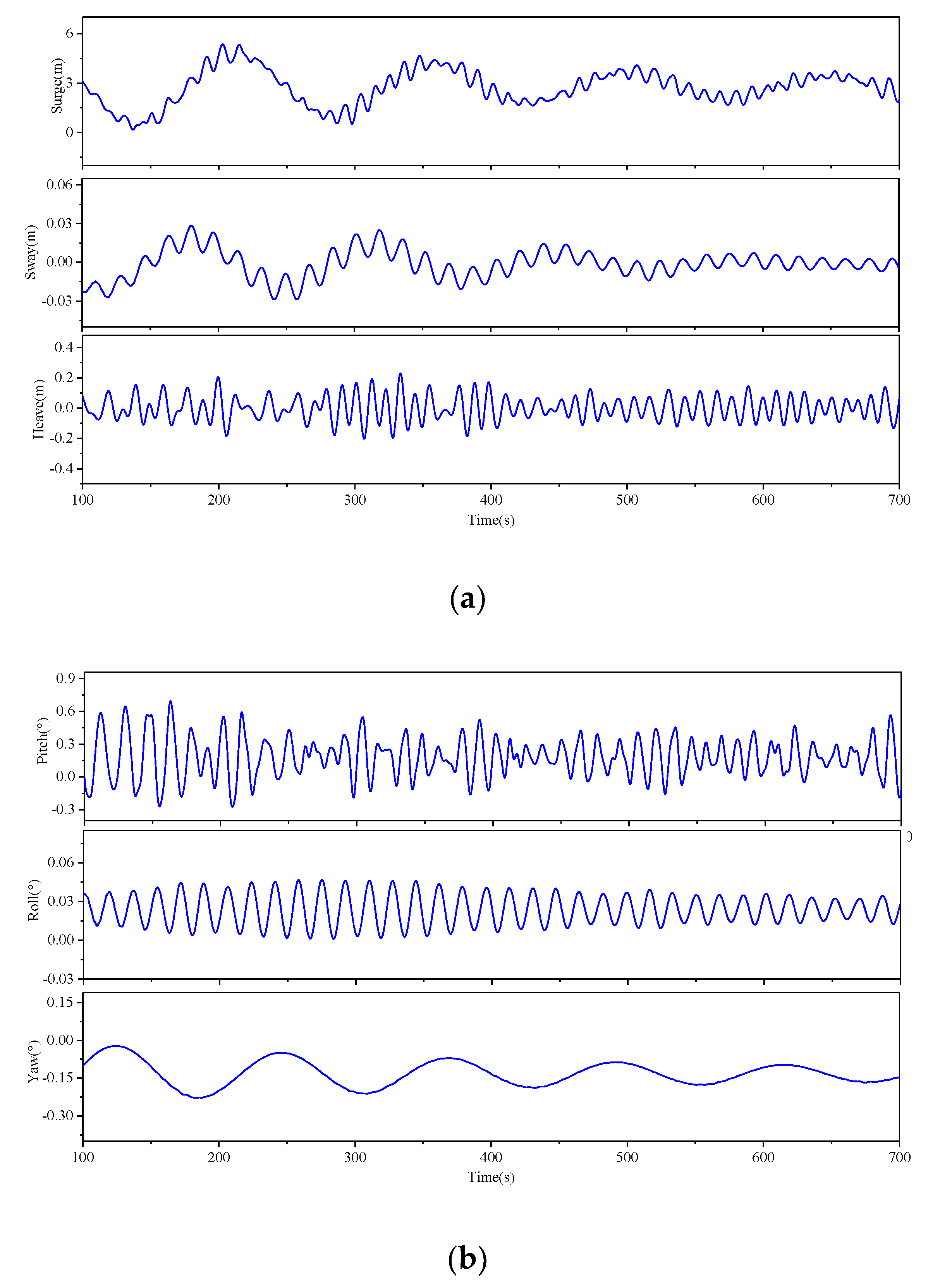
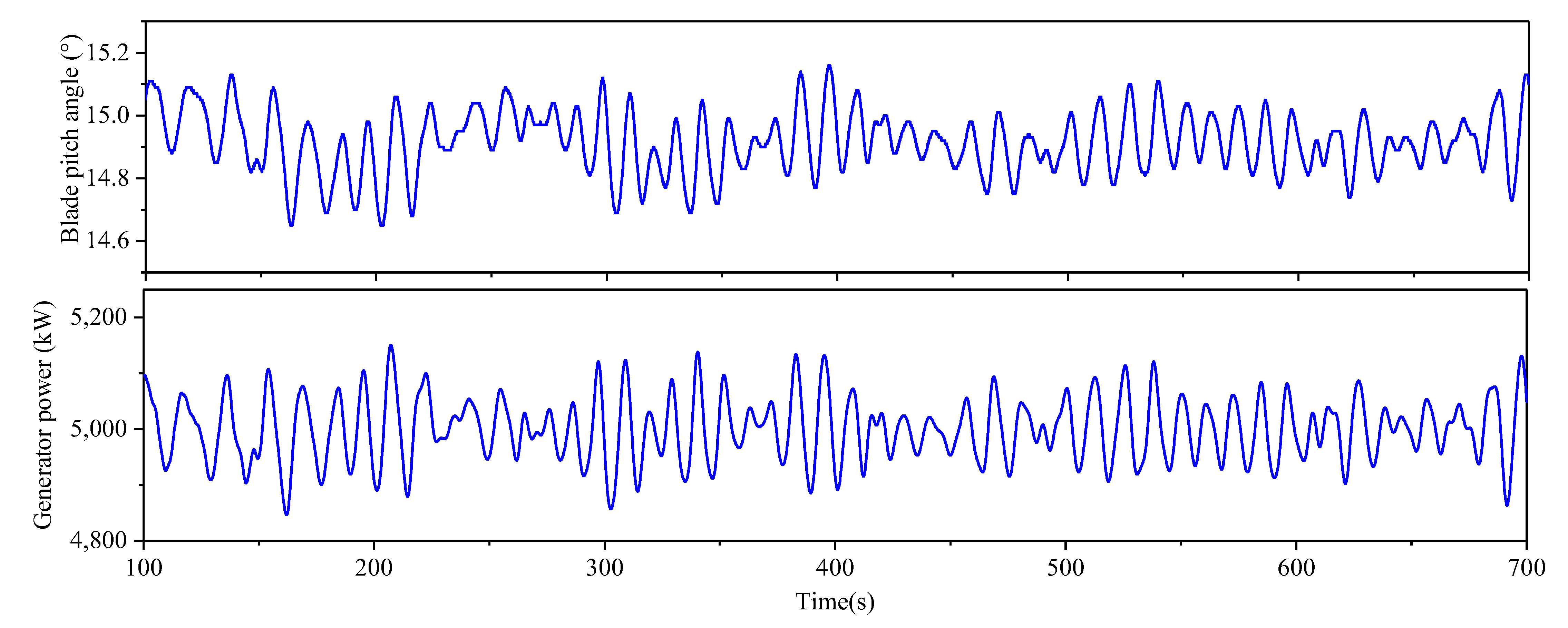
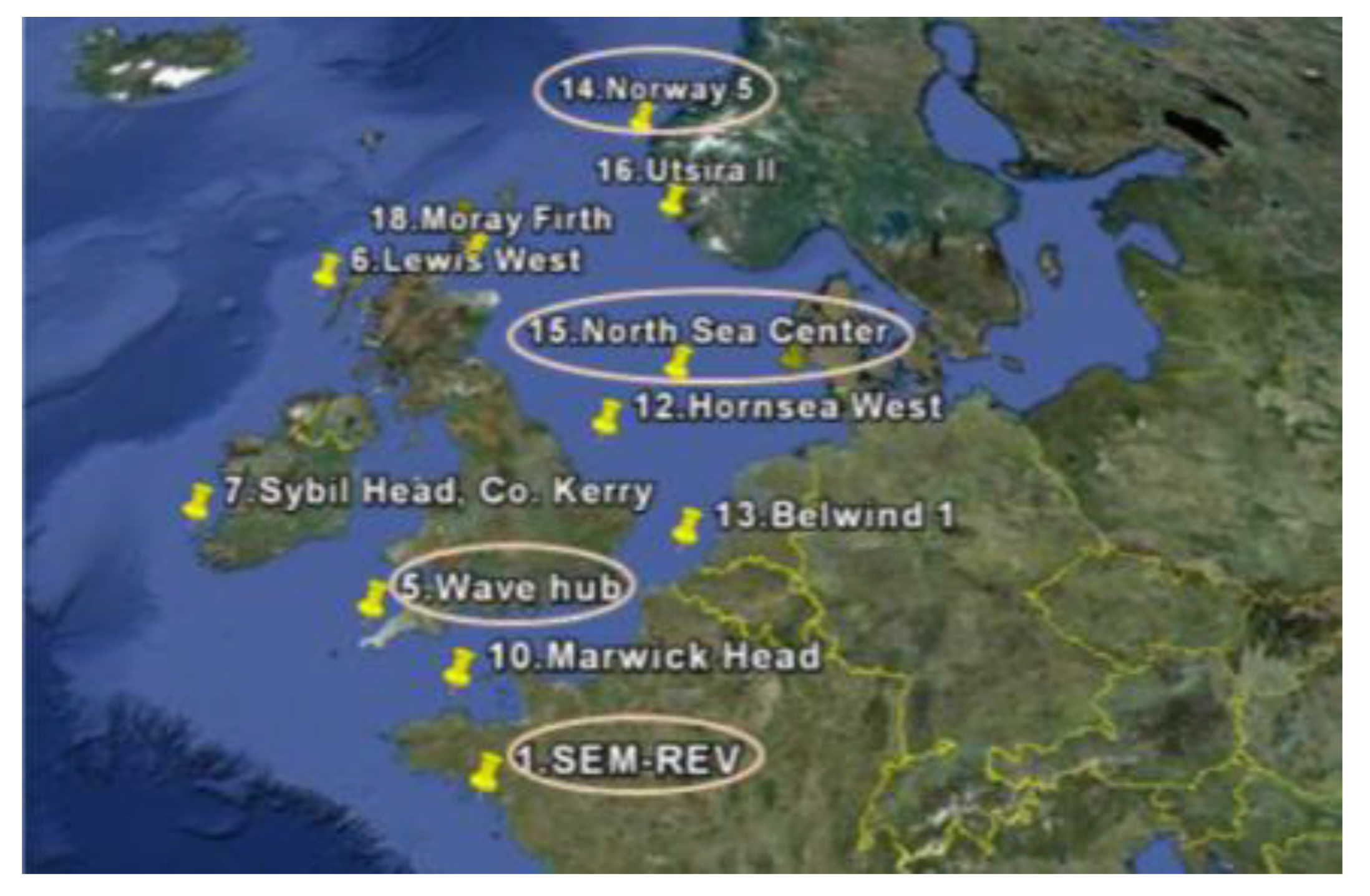
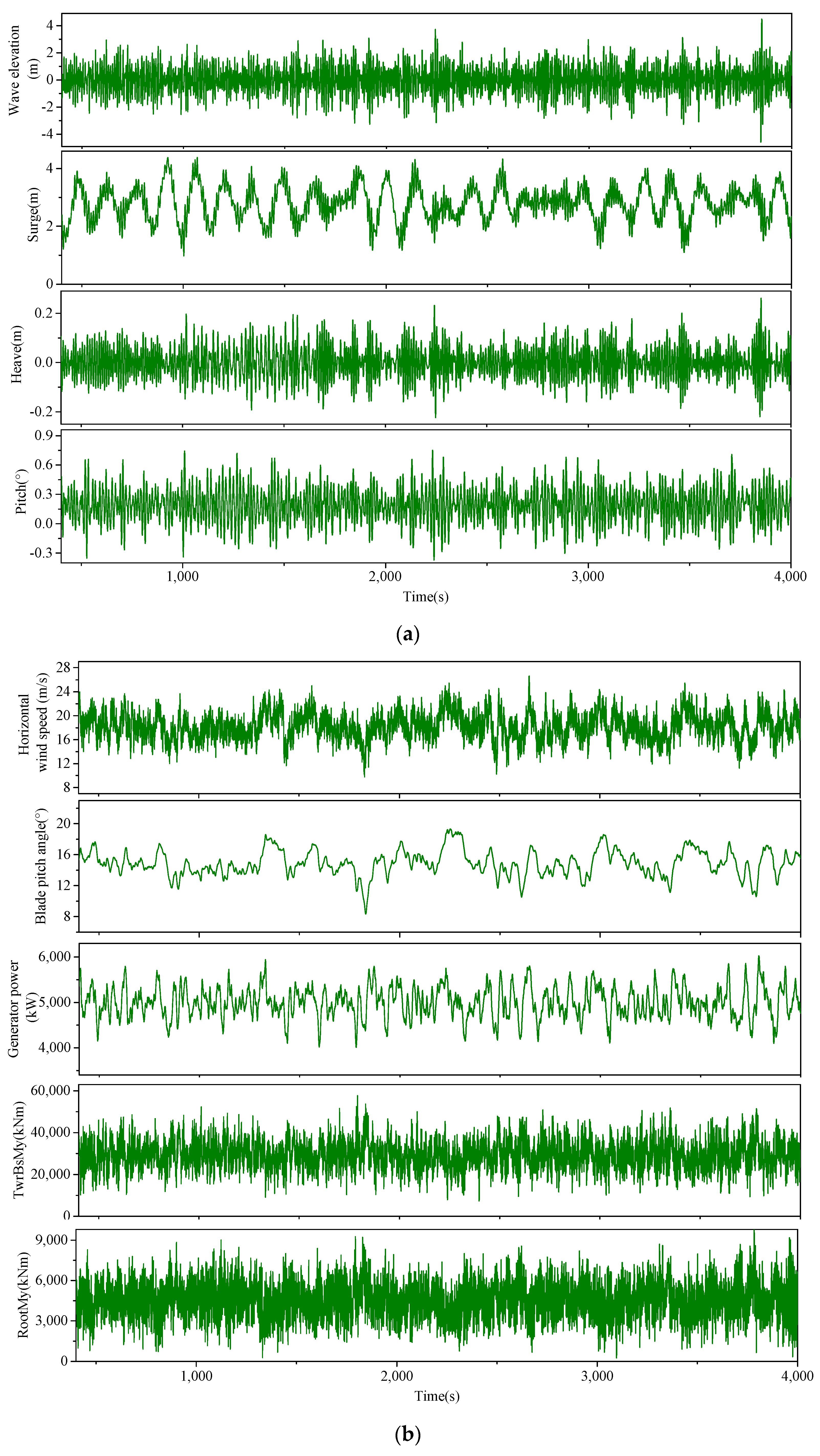
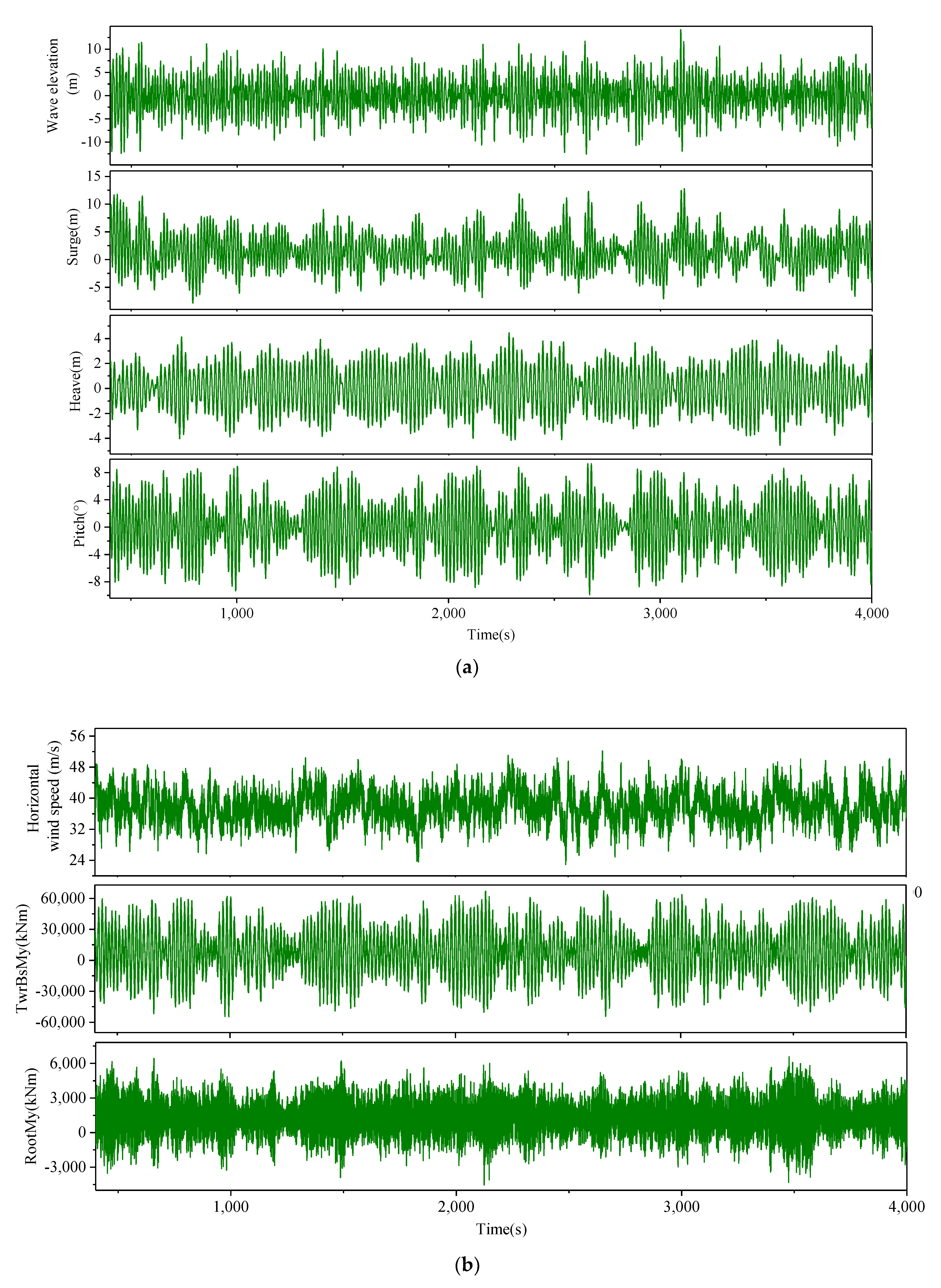
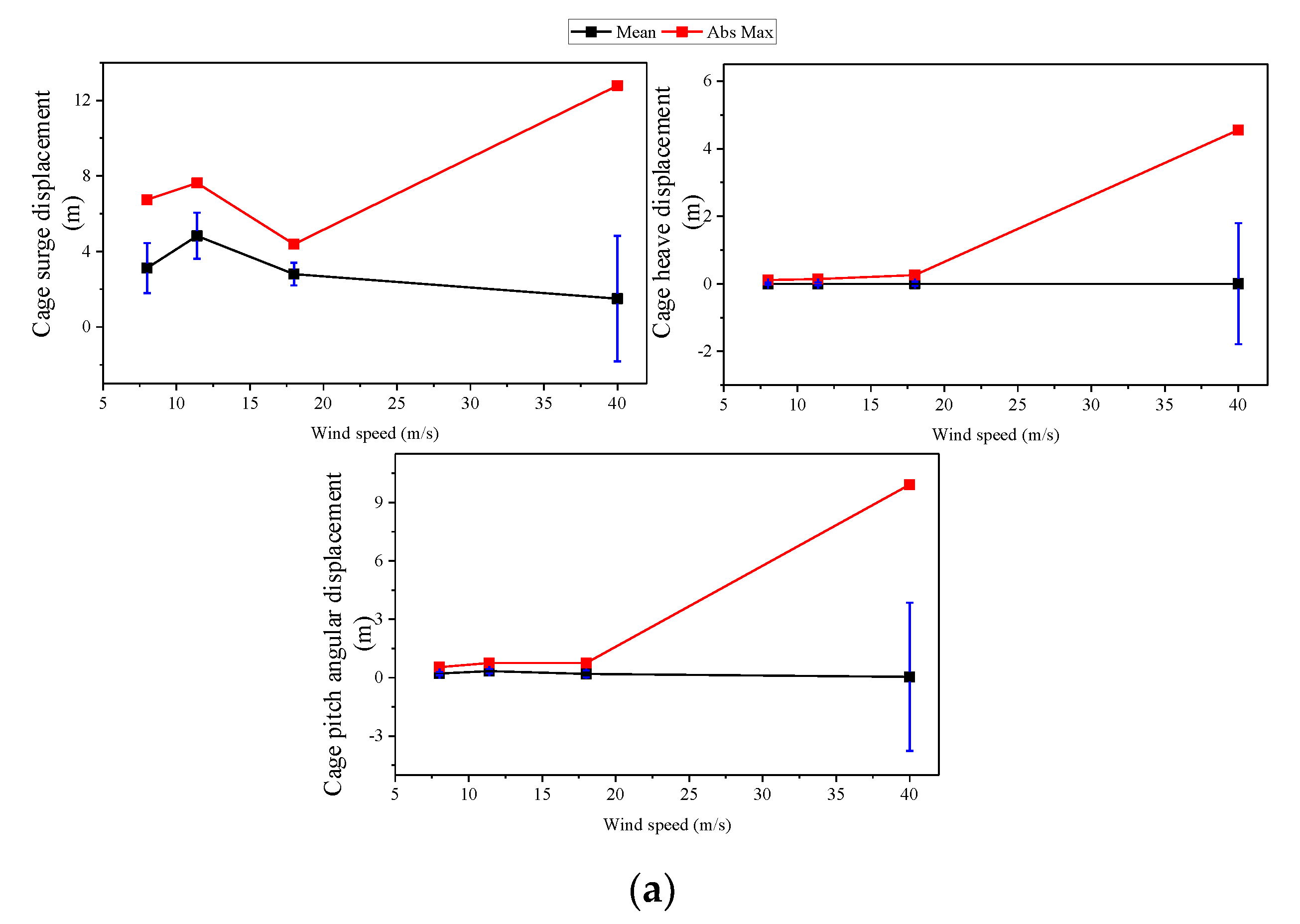
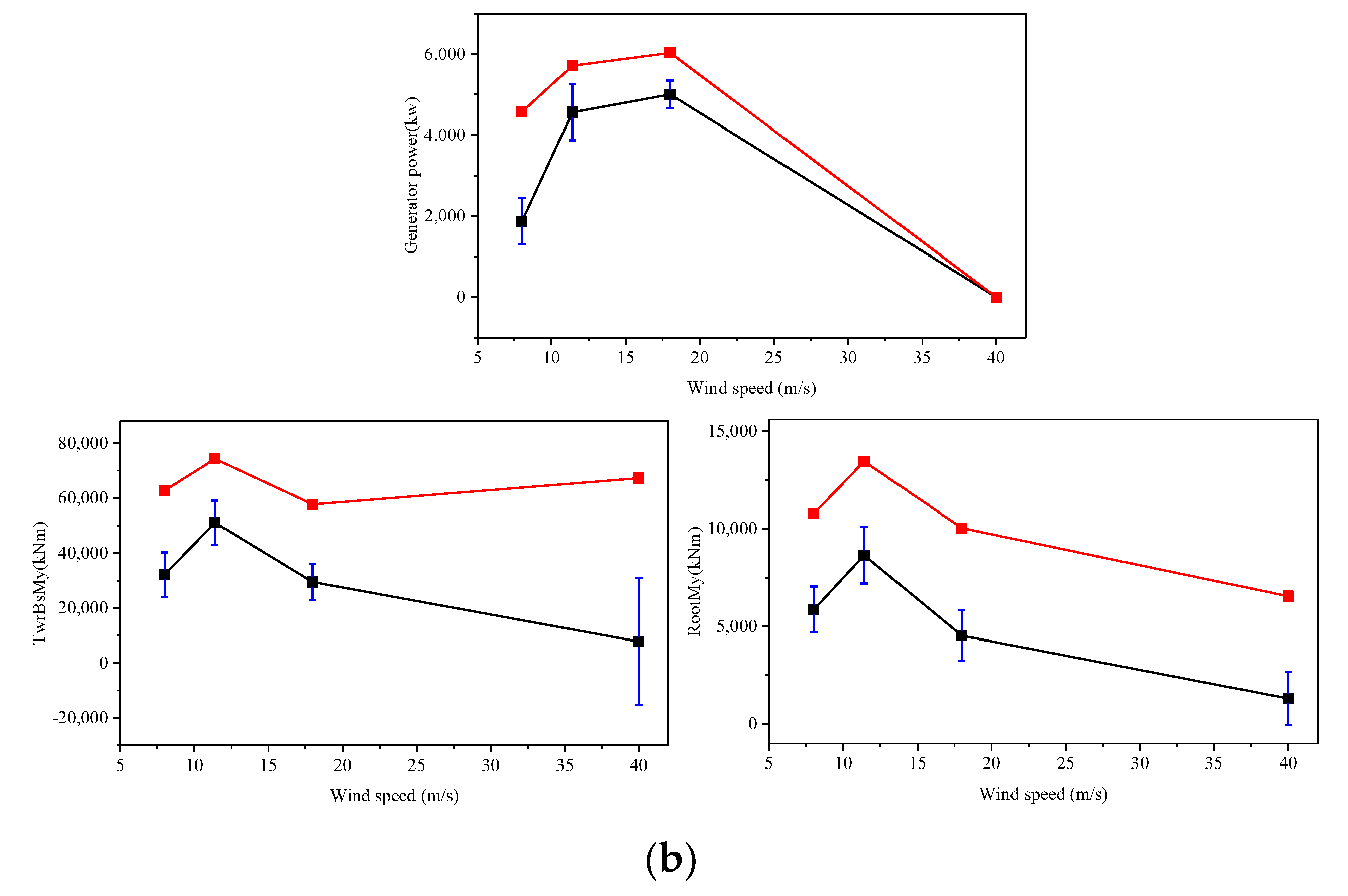
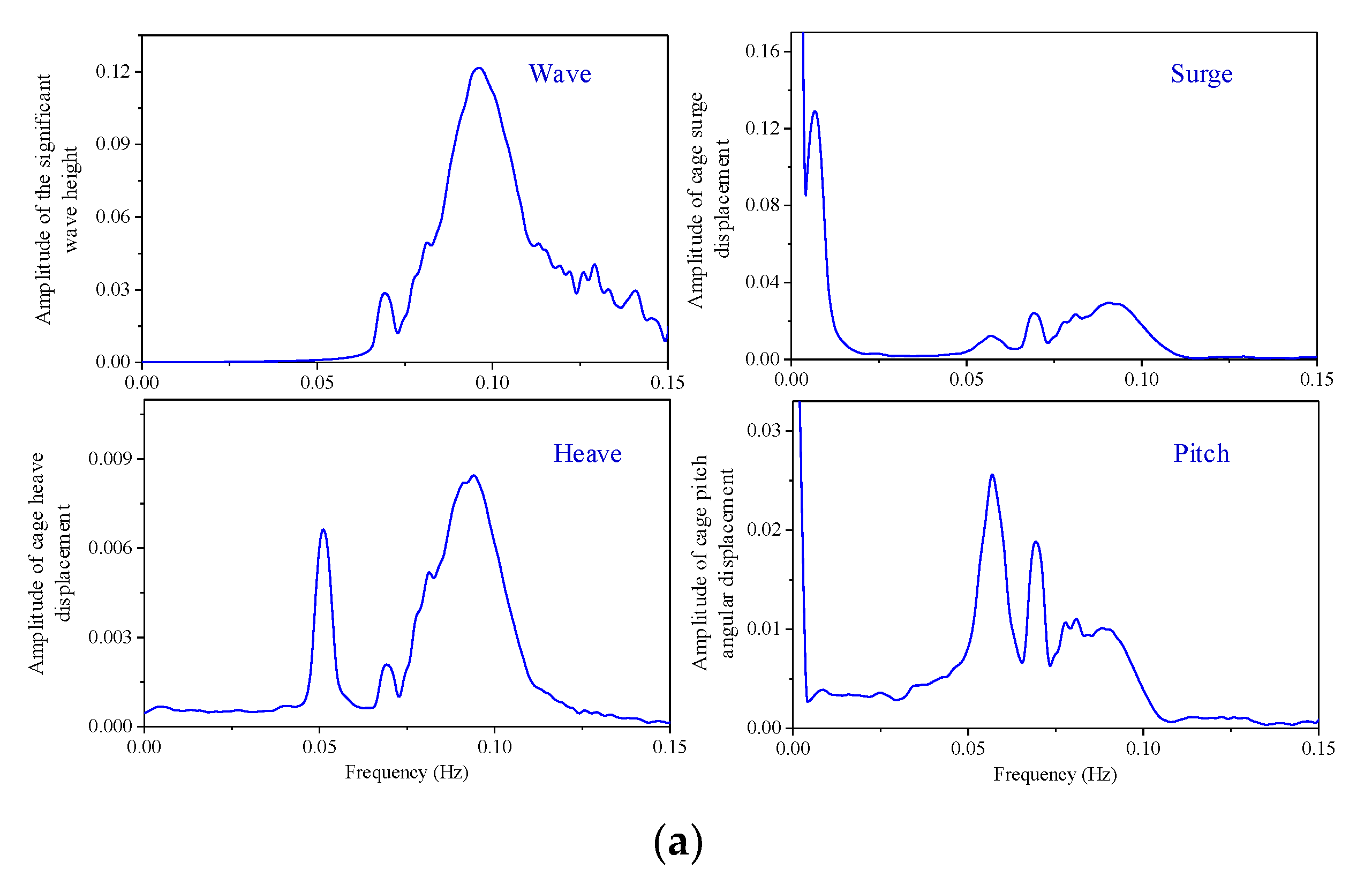
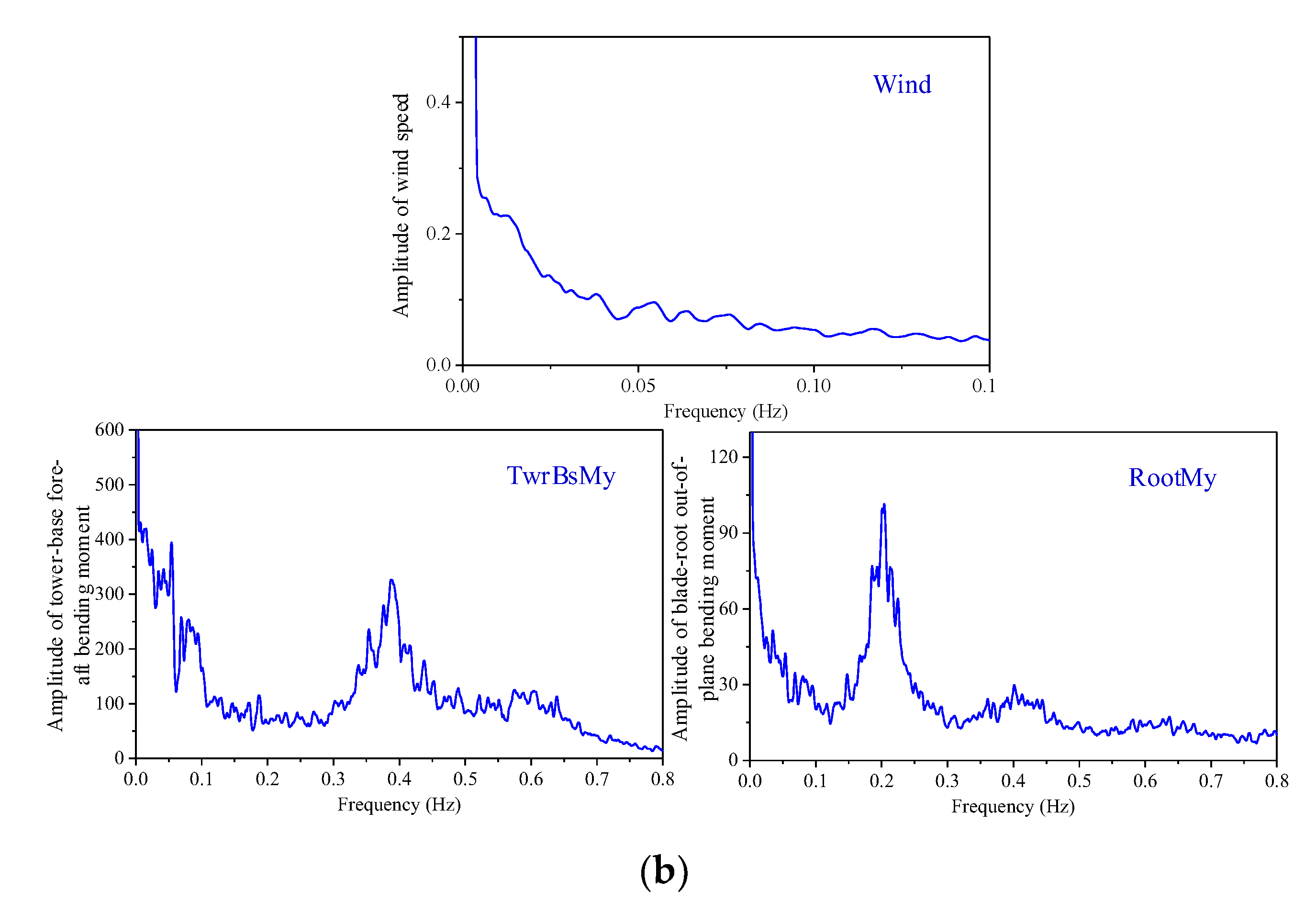
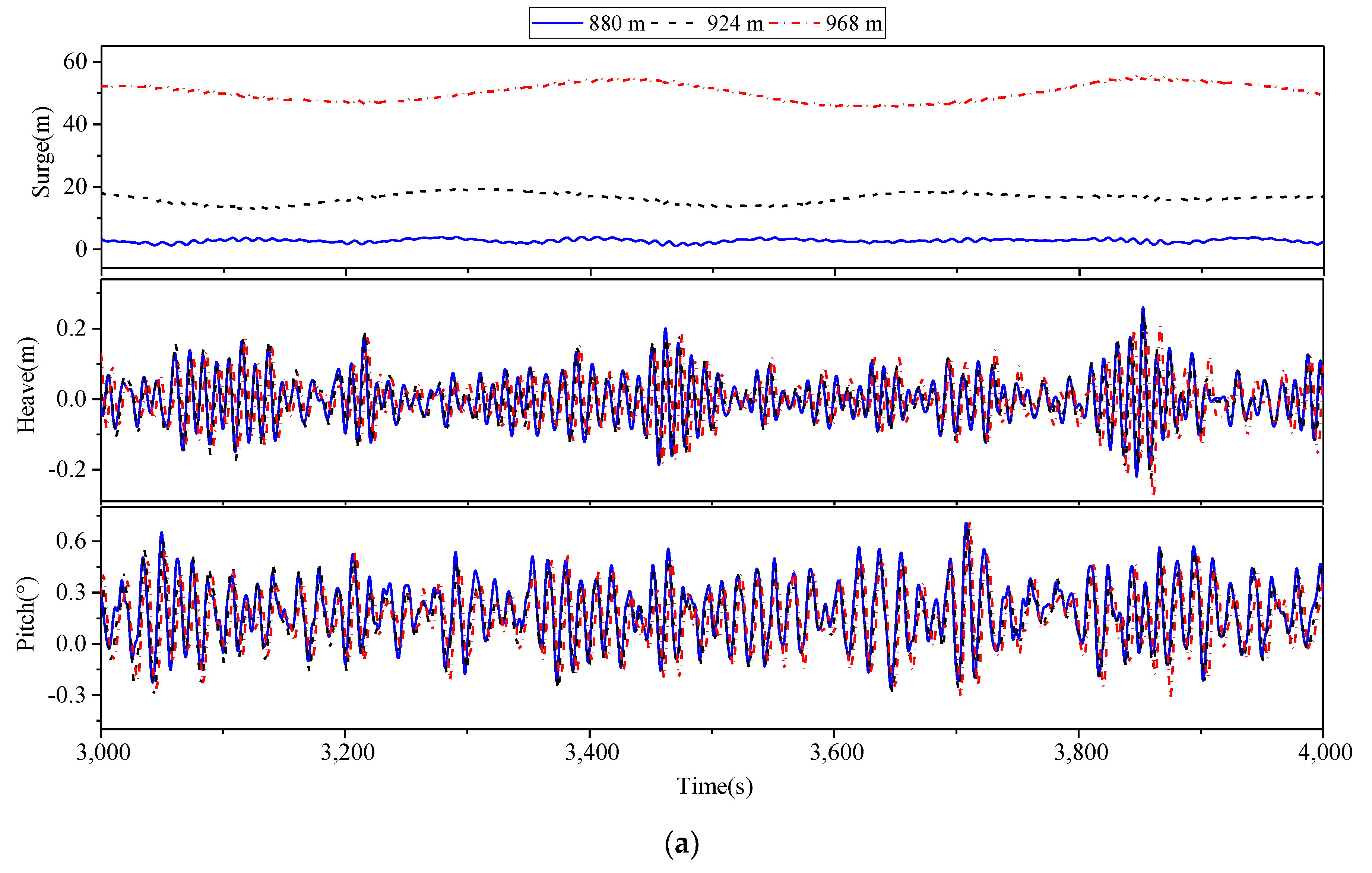
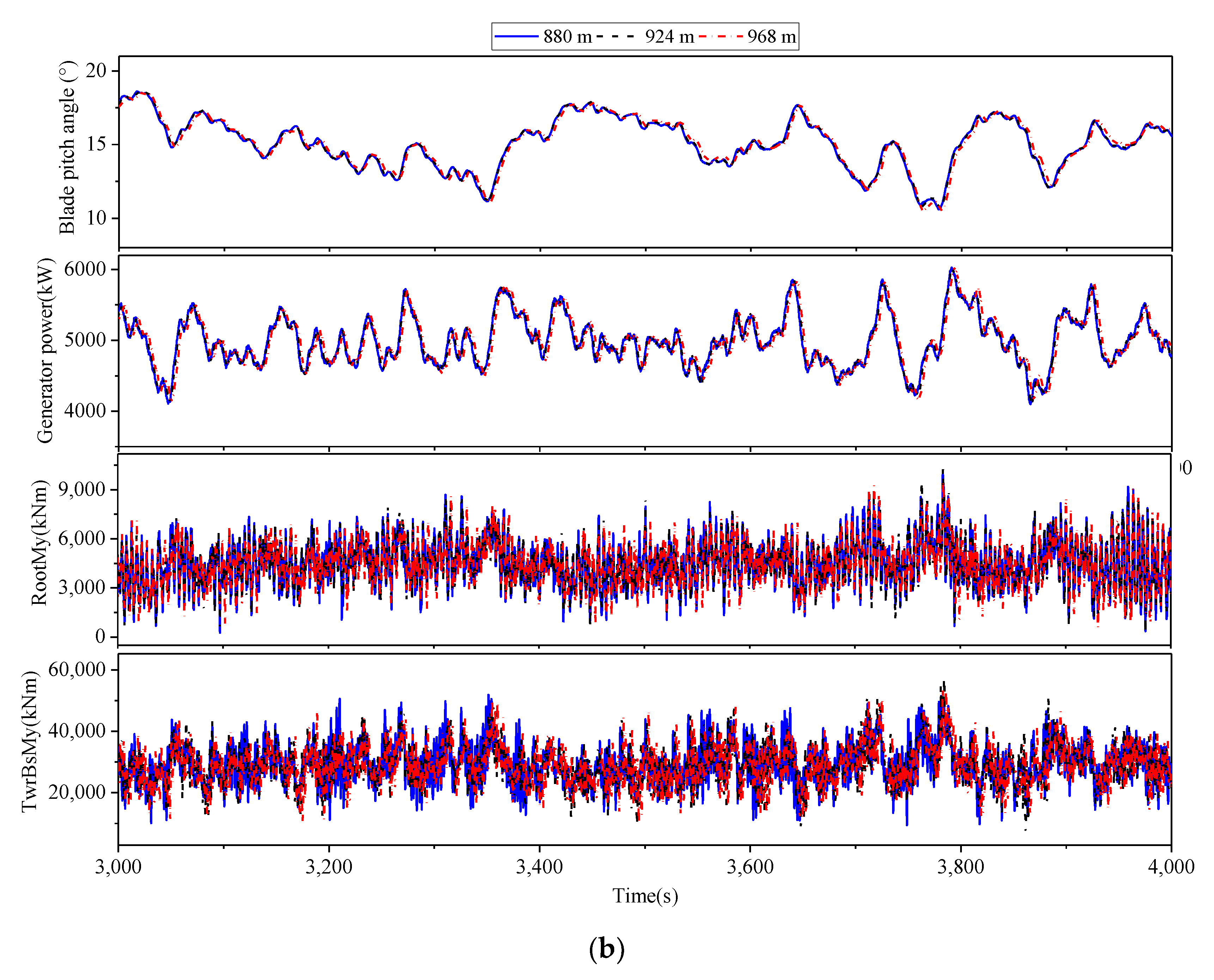
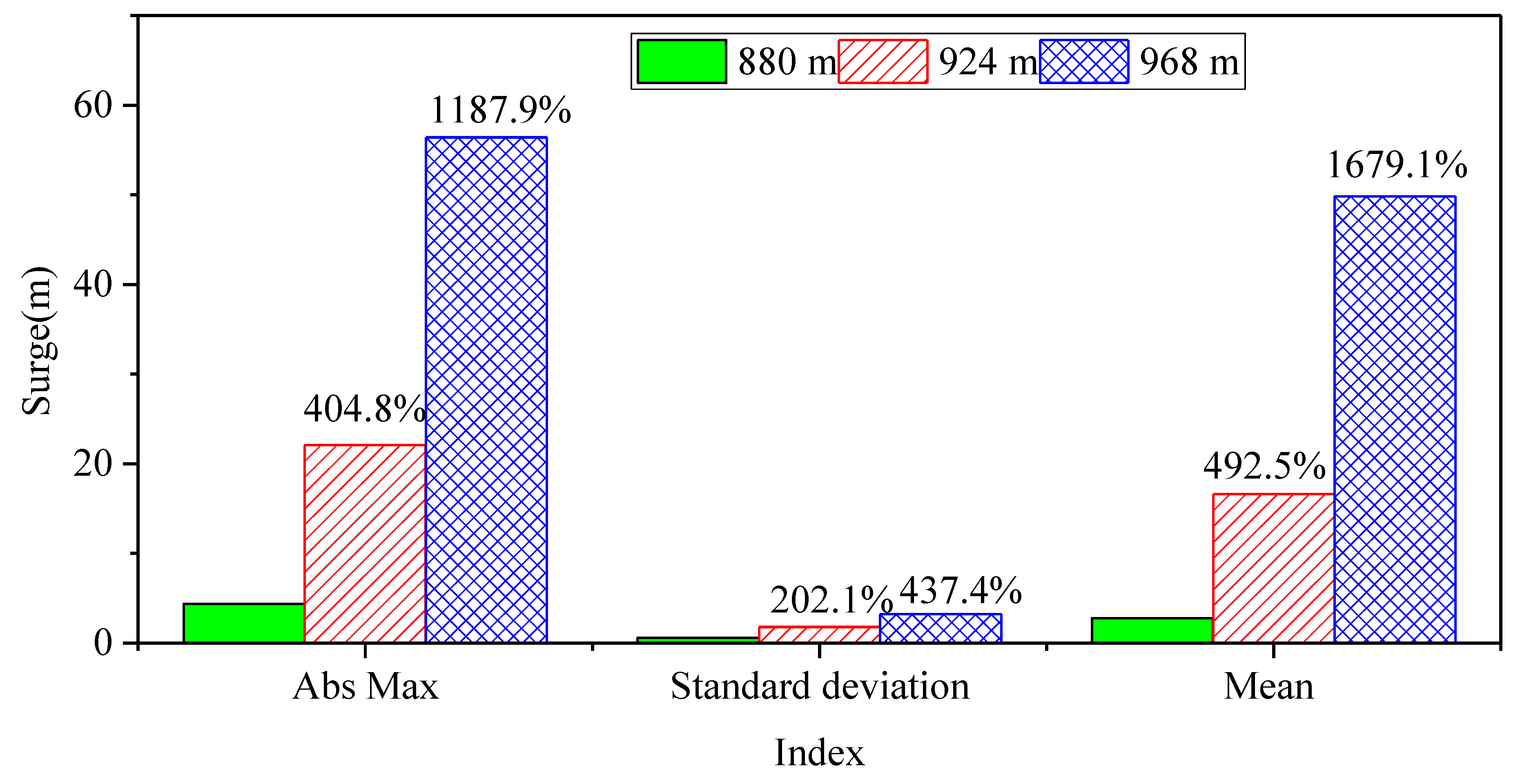

| Property | Value |
|---|---|
| Total draft | 41 m |
| Elevation of central column above the still water level | 10 m |
| Elevation of outside columns above the still water level | 10 m |
| Distance from central column centerline to outside column centerline | 50 m |
| Height of central and outside columns | 45 m |
| Height of heave plates | 6 m |
| Diameter of each outside column with a heave plate | 12 m |
| Diameter of each outside column without a heave plate | 6 m |
| Diameter of heave plates | 24 m |
| Diameter of central column | 6.5 m |
| Diameter of bracings | 1.6 m |
| Thickness of each outside column with a heave plate | 0.06 m |
| Thickness of each outside column without a heave plate | 0.03 m |
| Thickness of heave plates | 0.06 m |
| Thickness of central column | 0.03 |
| Thickness of bracings | 0.0175 m |
| Property | Value |
|---|---|
| Frame structure, bracing, ballast mass | 8.265 × 106, 1.305 × 106, 2.745 × 108 kg |
| Center of mass location below the still water level, including ballast and bracings | −34.07 m |
| Pitch inertia about the center of mass, including ballast and without bracings | 4.1867 × 1011 kg m2 |
| Roll inertia about the center of mass, including ballast and without bracings | 4.1867 × 1010 kg m2 |
| Yaw inertia about the center of mass, including ballast and without bracings | 7.5657 × 1010 kg m2 |
| Configuration | Value |
|---|---|
| Number of mooring lines | 4 |
| Angle between adjacent lines | 90° |
| Water depth | 200 m |
| Depth from fairlead to still water level | 35 m |
| Radius from anchors to cage centerline | 891.6 m |
| Radius from fairleads to cage centerline | 62 m |
| Unstretched mooring line length | 880 m |
| Property | Value |
|---|---|
| Chain type | Studless grade 4 |
| Nominal diameter | 0.153 m |
| Unit mass in water | 447 kg/m |
| Axial stiffness | 2.1 × 106 kN |
| Catalogue breaking strength | 2 × 104 kN |
| Transversal drag coefficient | 2.4 |
| Longitudinal drag coefficient | 1.15 |
| Added mass coefficient | 1 |
| Property | Parameter |
|---|---|
| Rating power | 5 MW |
| Rotor orientation, Configuration | Upwind, Three Blades |
| Control | Variable Speed, Collective Pitch |
| Drivetrain | High Speed, Multiple-Stage Gearbox |
| Rotor, Hub diameter | 126 m, 3 m |
| Hub height | 90 m |
| Cut-In, Rated, Cut-Out wind speed | 3, 11.4, 25 m/s |
| Cut-in, Rated rotor speed | 6.9 rpm, 12.1 rpm |
| Rated tip speed | 80 m/s |
| Overhang, Shaft tilt, Precone | 5 m, 5°, 2.5° |
| Rotor, Nacelle mass | 110,000 kg, 240,000 kg |
| Property | Parameter |
|---|---|
| Elevation to tower base above still water level | 10 m |
| Elevation to tower top above still water level | 87.6 |
| Overall tower mass | 249,718 kg |
| Center of mass location above still water level | 43.4 m |
| Structural damping ration | 1% |
| DOF | Natural Frequency (Hz) |
|---|---|
| Surge | 0.00667 |
| Sway | 0.00667 |
| Heave | 0.05111 |
| Pitch | 0.05778 |
| Roll | 0.05778 |
| Yaw | 0.00778 |
| Case | Mean Wind Speed (m/s) | Significant Wave Height (m) | Wave Peak Period (s) | Turbulence Intensity (%) | State |
|---|---|---|---|---|---|
| 1 | 8 | 2 | 10.3 | 17 | Operating |
| 2 | 11.4 | 2.5 | 10.2 | 15 | Operatng |
| 3 | 18 | 4.1 | 10.5 | 13 | Operatng |
| 4 | 40 | 15.6 | 14.5 | 11 | Parked |
Publisher’s Note: MDPI stays neutral with regard to jurisdictional claims in published maps and institutional affiliations. |
© 2022 by the authors. Licensee MDPI, Basel, Switzerland. This article is an open access article distributed under the terms and conditions of the Creative Commons Attribution (CC BY) license (https://creativecommons.org/licenses/by/4.0/).
Share and Cite
Zhang, C.; Xu, J.; Shan, J.; Liu, A.; Cui, M.; Liu, H.; Guan, C.; Xie, S. Preliminary Study on an Integrated System Composed of a Floating Offshore Wind Turbine and an Octagonal Fishing Cage. J. Mar. Sci. Eng. 2022, 10, 1526. https://doi.org/10.3390/jmse10101526
Zhang C, Xu J, Shan J, Liu A, Cui M, Liu H, Guan C, Xie S. Preliminary Study on an Integrated System Composed of a Floating Offshore Wind Turbine and an Octagonal Fishing Cage. Journal of Marine Science and Engineering. 2022; 10(10):1526. https://doi.org/10.3390/jmse10101526
Chicago/Turabian StyleZhang, Chenglin, Jincheng Xu, Jianjun Shan, Andong Liu, Mingchao Cui, Huang Liu, Chongwu Guan, and Shuangyi Xie. 2022. "Preliminary Study on an Integrated System Composed of a Floating Offshore Wind Turbine and an Octagonal Fishing Cage" Journal of Marine Science and Engineering 10, no. 10: 1526. https://doi.org/10.3390/jmse10101526
APA StyleZhang, C., Xu, J., Shan, J., Liu, A., Cui, M., Liu, H., Guan, C., & Xie, S. (2022). Preliminary Study on an Integrated System Composed of a Floating Offshore Wind Turbine and an Octagonal Fishing Cage. Journal of Marine Science and Engineering, 10(10), 1526. https://doi.org/10.3390/jmse10101526







